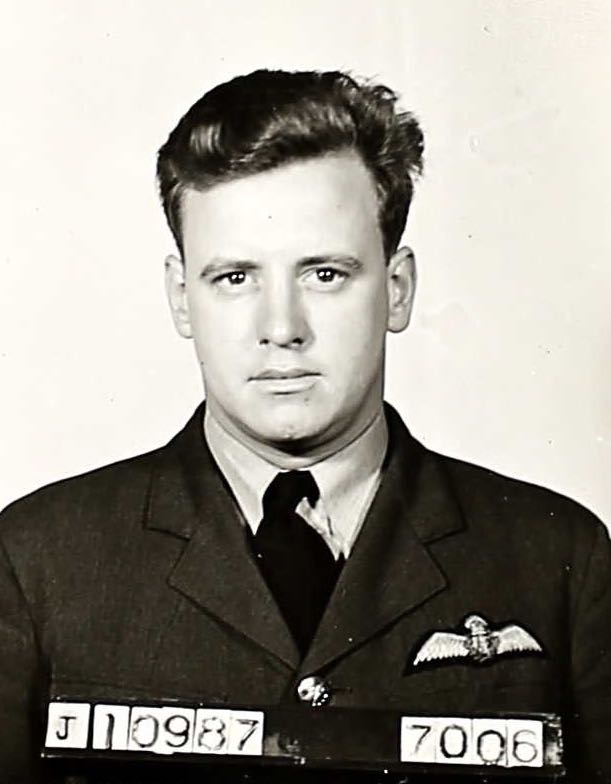
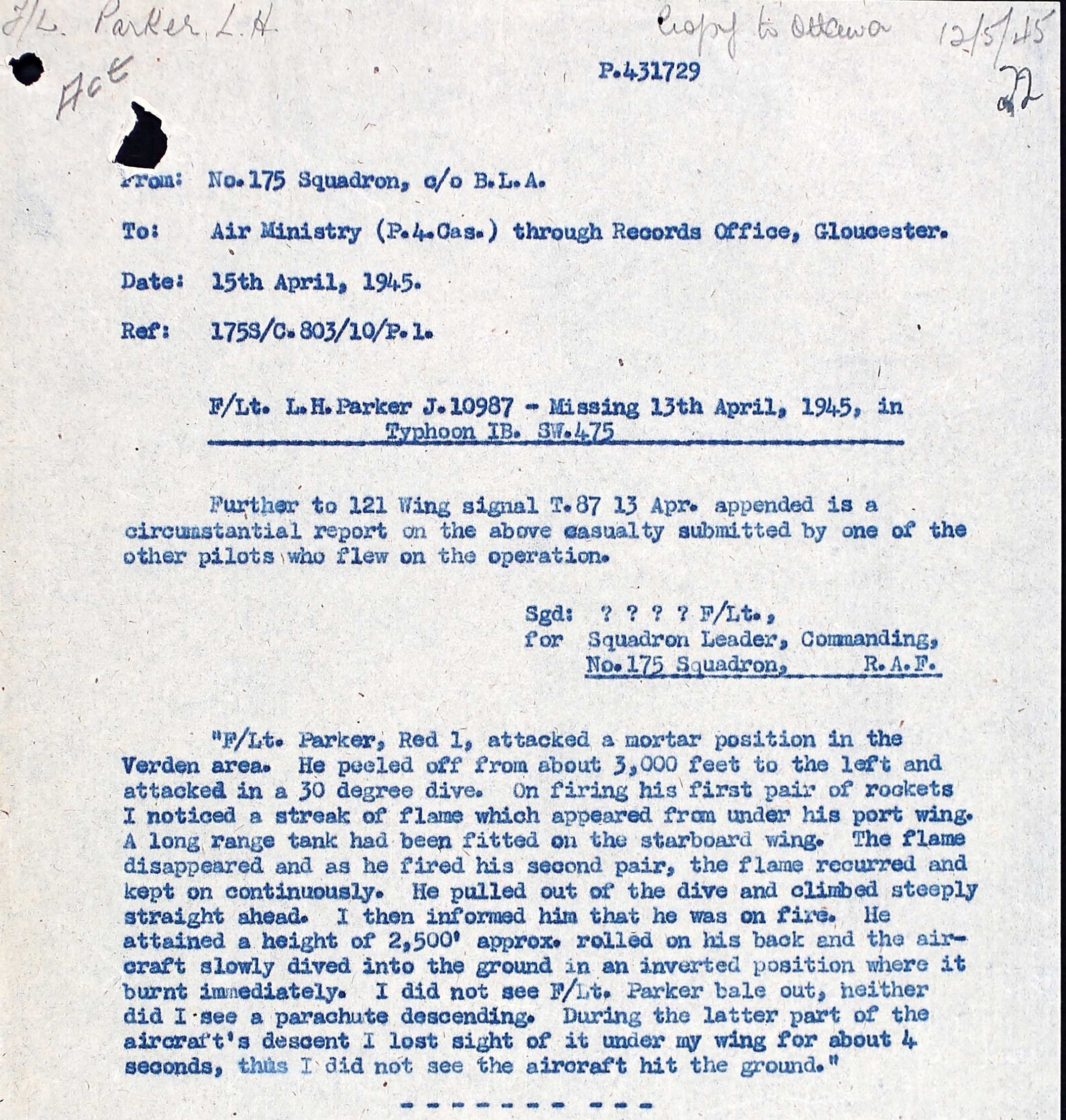
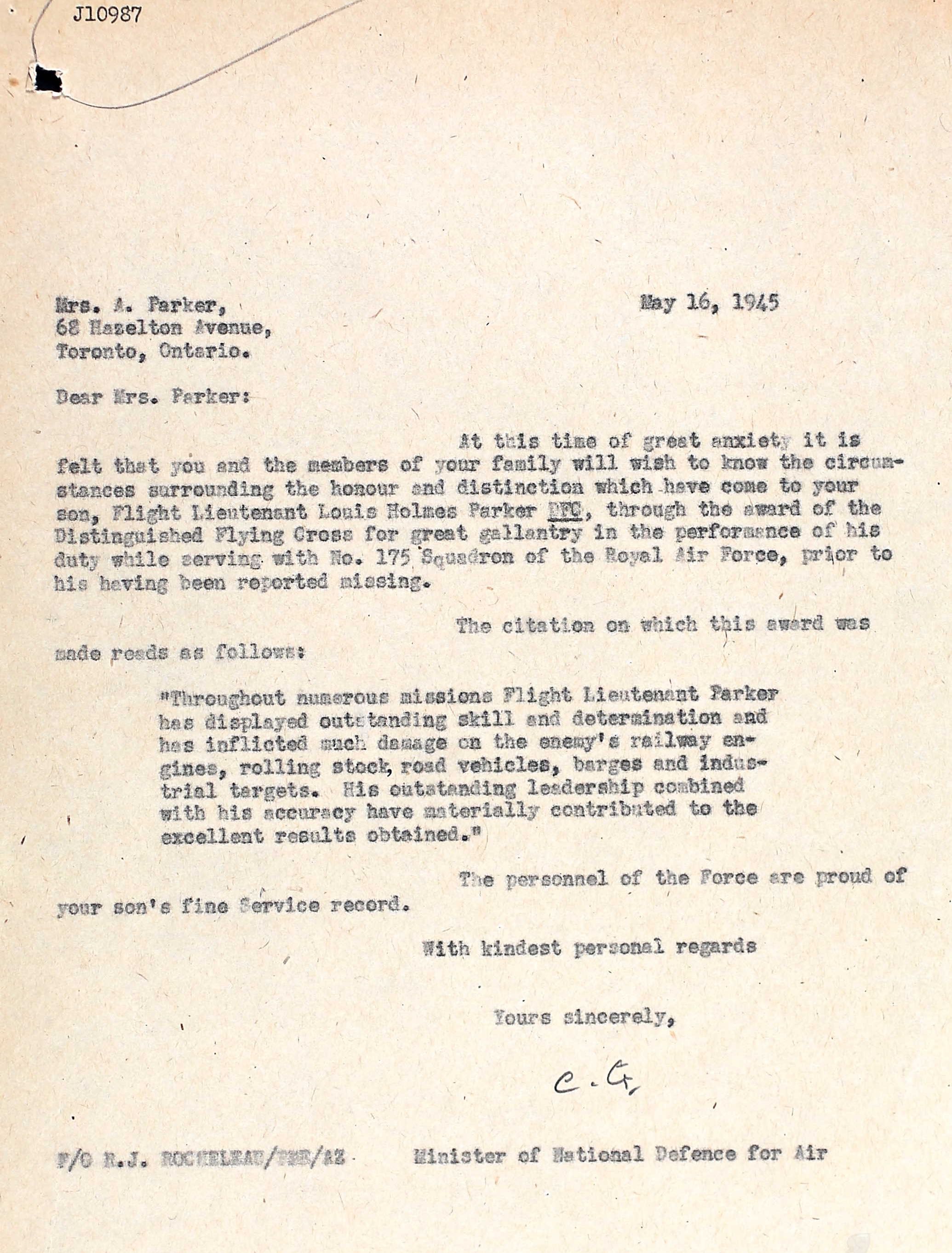
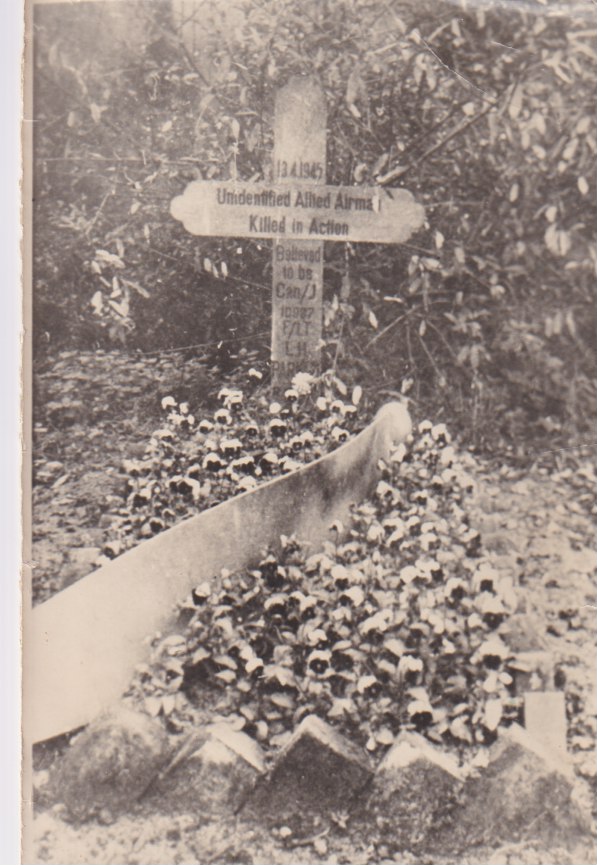
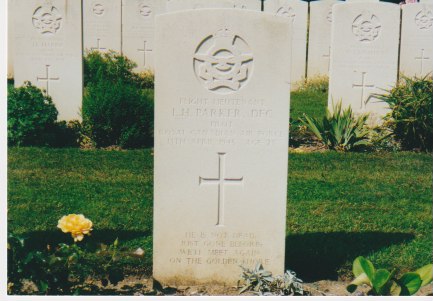
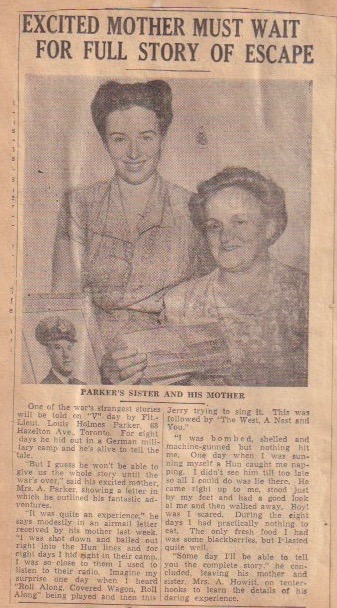
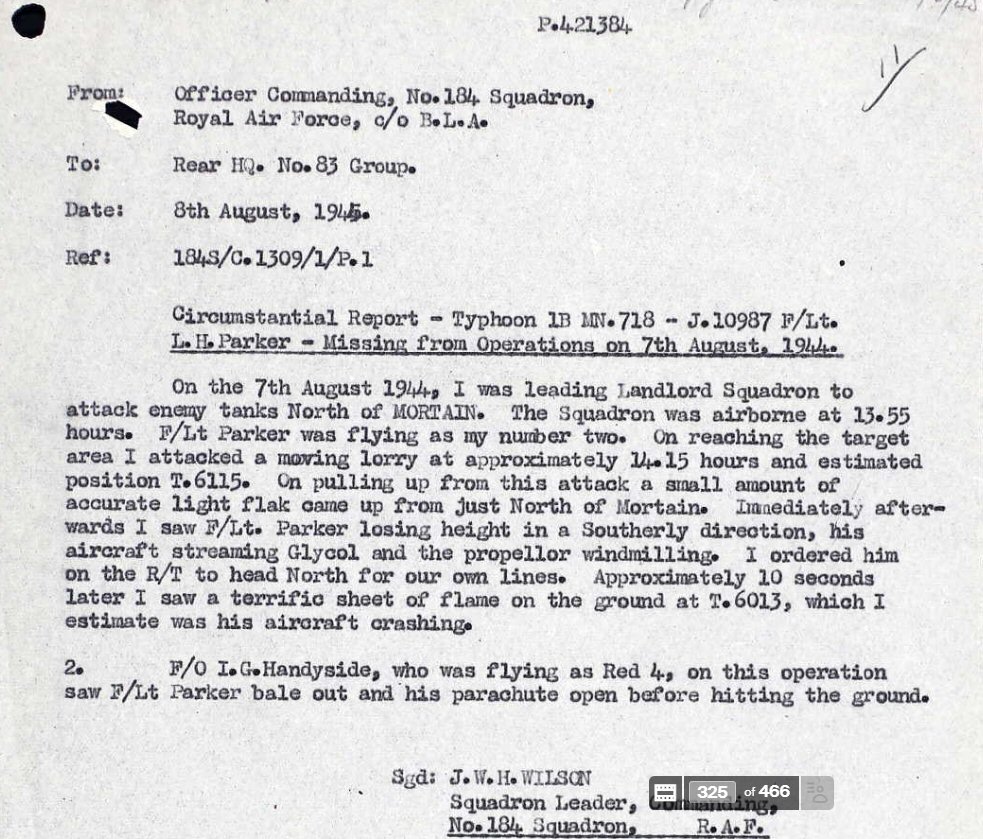




May 19, 1921 - April 13, 1945











Louis Holmes Parker was the son of Thomas Holmes (landscape gardener), deceased 1942, and Annie (nee Scholes) Parker of Toronto, Ontario. He was born in Oldham, England. The family moved to Toronto when Parker was 3 years old. Parker had one brother, Alvin Thomas, and one sister, Mrs. Edith Grace Howitt. The family was Baptist.
He had worked at the Department of External Affairs from July 1940 to January 1941 as a clerk in the passport office, then was transferred to the Department of National Revenue until June 1941, as a clerk in the customs office. He left to enlist in the RCAF.
He liked boxing, basketball, swimming, baseball and football, as well as to shoot rifles. He stood 5' 6" tall and weighed 158 pounds. He had brown eyes and brown hair. "Clean cut type. Education would fit him for Observer." Also: "Alert, fairly quick lad of average intelligence. Appears stable and well adjusted. Rather easy-going. Responsible in attitude towards work." F/L C. G. Stogdill
He was at No. 3 ITS, Victoriaville, August 20, 1941. "Good educational and home background. Solid and dependable. Keen and alert. Sincere, determined, pleasant personality. Enthusiastic." He was 34th in his class of 102.
He was at No. 4 EFTS, Windsor Mills, September 24, 1941. "Would be above average if he would apply himself. Good on aerobatics and instrument flying. Inclined to be careless and needs constant attention." At Ground Training: "15 out of 30 in class. Needs to have ambition stimulated. More or less content to just go along."
He was at No. 9 SFTS, Summerside, November 22, 1941 and received his wings in April 1942. "Above average student in Ground Training. Hard, conscientious worker. Conduct and deportment good." He was seen as a "capable student who is quick to learn, keen and tries hard. Shows appreciation. A good all-round intelligent student." Parker requested to be a Fighter or Bomber Pilot, or GR.
He then travelled to Rockcliffe until June 1942, when he was sent to 132 F Squadron, Sea Island June 4, 1942. He went to Pat Bay in July until October, then to Tofino, then to Boundary Bay by July 1943.In September 1943, he was sent to Halifax and was then overseas by October 19, 1943. He joined 184 Squadron August 5, 1944.
Parker was declared missing from 184 Squadron on August 7, 1944, then was safe.
He was sent to 175 Squadron January 1, 1945.
On April 13, 1945, at 1620 hours, No. 175 Squadron reported that F/L Parker, piloting Typhoon SW475 left base to carry out an armed reconnaissance against mortar and light flak positions near Volkensen, Germany. He peeled off from about 3000 feet to the left and attacked in a 30 dgree dive. He was last seen going down to attack enemy positions about 12 miles SE of Bremen, Germany. The wing of his aircraft was seen to be in flames. A witness said that "On firing his first pair of rockets, I noticed a streak of flame which appeard from under his port wing. A long range tank had been fitted on the starboard wing. The flame disappeared and as he fired his second pair, the flame recurred and kept on continuously." The aircraft pulled out of the dive, climbed up, then turned over and dived in flames to the ground where fire enveloped the Typhoon. Parker was not seen to bale out. No. 151 Repair Unit reported that the aircraft was located at Langwedel, deeply buried in soft ground. The area was waterlogged and although pumps were used to drain the water, no trace could be found of Parker's body. A cross marked with his name was erected at the scene of the crash.
Lou, as he was known, was said to be very popular on the Squadron. He had come to 175 Squadron at the beginning of 1945 and had done invaluable work, both in flying and in training new pilots, plus helping with the running of the squadron, wrote S/L R. W. Campbell, to Parker's mother.
He was awarded the DFC in May 1945, posthumously.
From my RCAF collector friend, Rob: "The logbook is interesting as he wrote fairly descriptive accounts of his sorties. He was shot down on his very first operational sortie with 184 Squadron on, I believe, August 7, 1944 during the Battle of Mortain during the Falaise Gap offensive. This became known as the Day of the Typhoon. He was hit by flak and bailed out. He hid amongst German Panzer troops for two weeks, surviving on black berries and what he had of his escape kit. He even had to feign being dead when he was approached by a German soldier. He was eventually picked up by U.S. forces and returned to his squadron. He became a successful flight commander, completed many operations, and survived until within two weeks of the end of the war when his aircraft exploded when he fired his rockets at a German gun position. It is not known for sure whether one of his rockets prematurely detonated or his aircraft was hit by flak. His evasion of the Germans I described is detailed in a letter to his mother as well as in newspaper articles. It is very interesting reading."
Additional info, December 29, 2023, from Frank Dutil, 438 Squadron Historian: He joined 184 Squadron August 5, 1944. Parker was declared missing from 184 Squadron on August 7, 1944, then was safe.
More info: Aircraft was number 2 in a flight of 4 taking off at 13h55 from airfield B5 Le Fresney Camille (France). It was hit by a burst of accurate light flak while pulling out from attacking an enemy tank. Aircraft was observed by the flight leader slowly losing altitude southward trailing glycol and with the propeller windmilling. He also reported seeing the aircraft impact the ground and exploding. The flight’s number 4 confirmed he saw the pilot bale out and parachuting safely to the ground. The pilot landed behind enemy lines. He successfully evaded capture for 7 days, eventually connecting with a US Army patrol and regained his unit.
Intelligence report citing Parket upon return to his unit: "I took off from B.5 airfield (T.8976) on 7 August around 1400 hours in a Typhoon. I was on an armed reconnaissance. I had just straffed a tank and was pulling away when I got hit by flak. The aircraft caught fire. I abandoned the aircraft from about 1,000 feet. I was fortunate in finding a small clearing in the woods T.6002 (250,000 3a T.8) to land on. My landing was a bit heavy and I injured my left ankle. I left my harness and parachute where I landed. I headed in a southerly direction for about a couple of hours through hilly and wooded country. Before I reached the road running from Le Teilleul (Y.6498) to Bunis (Y.5697). I noted several German lorries and soldiers were walking around the area too. I immediately back-tracked into the woods. This was around 2100 hours. I found myself a good hideout among the ferns and bushes and stayed there for the night. On the morning of the 8th I made my way down a valley. I was on the east side of it, to fill my water bottle. I continued on up the other side of the hill and found a large rock behind which I sat and watched the German movement in the camp below. I stayed the night in a crevice of the rock. On 9 August around 1100 hours I headed off in a southwesterly direction . I had hardly gone a few hundred yards down the slope when I heard Germans shouting to each other and moving around in a business-like manner. I made straight back to the rock. For the next few hours I stayed in my hole in the rock - later I ventured out and went towards the creek at the bottom of the hill. I was prevented from doing this owing to more German activity. I found a pool where I filled my water bottle. On returning to the rock I noticed more activity going on below and two soldiers immediately above the cave. When they disappeared I made for my original hiding place. On the morning of the 11th, while I was a little way away from the cave to get a little warmth, I noticed a German soldier idly surveying the countryside. As I was in dry brushwood and every move made a crackling noise I lay still; slowly he walked towards my position. Eventually he came up and stood by my side looking at me. I lay as still as a log. I managed to follow his movements with half an eye closed. Slowly he made off. I waited till he was out of sight. I gathered up my water bottle and revolver and made off to my hole in the rock. I made this my resting place for three more nights (August 14 morning) All three nights they bombed and straffed the woods near where I was; several fell uncomfortably near. On the morning of the 14th I made my way towards the German encampment. At first I skirted it. As I heard no movement I entered the wood where they had been. One tank had been destroyed, a few light vehicles were lying around. Several articles of clothing were also strewn around the place. The only Germans I saw were two dead ones beside the tank. I made my way towards the Le Teilleul - Bunis road. I waited until a jeep came along the road. I stepped out and put my hands up. The jeep stopped and picked me up, taking me back to my airfield by several different forms of transport."
LINKS: